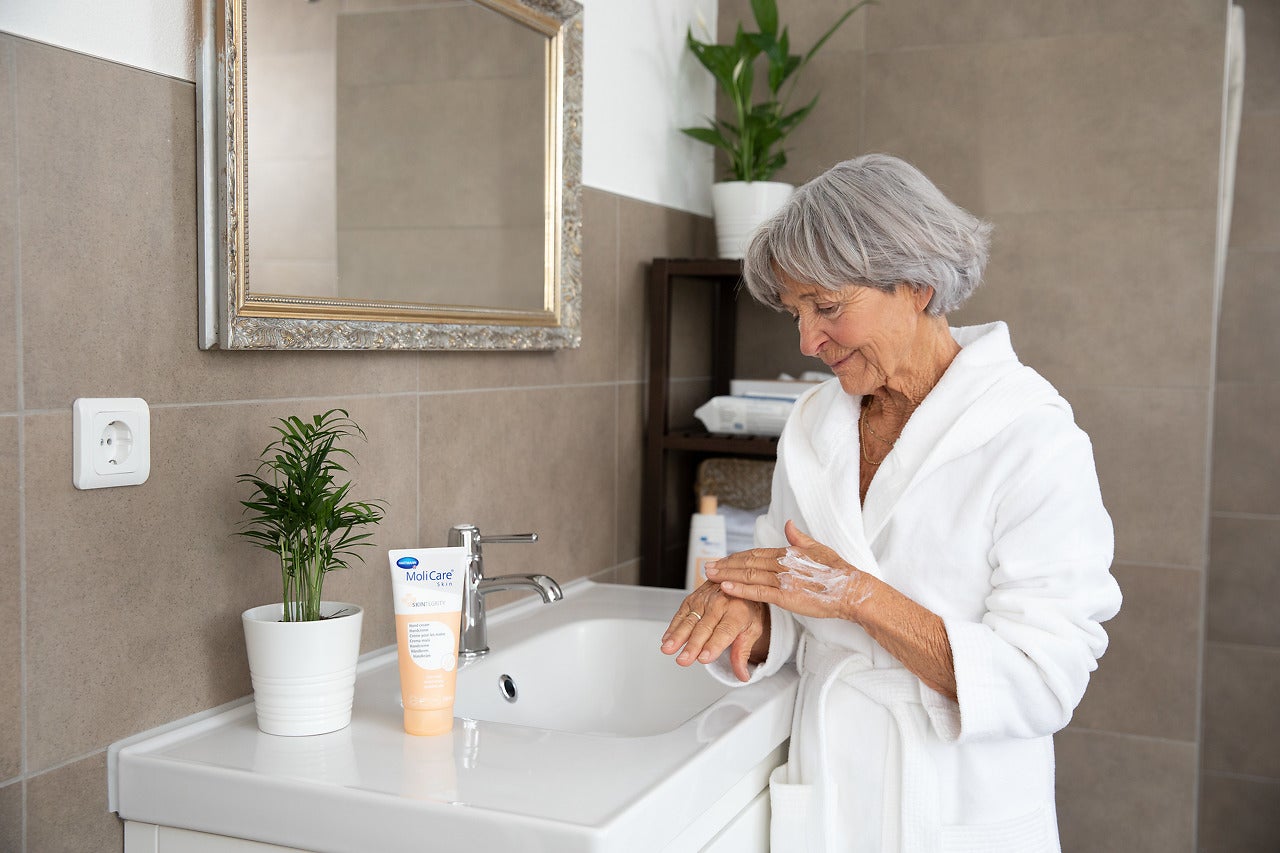Skin Care
Why Skin Care Is So Important
Your skin does more than you might think. As the body’s largest organ, it acts as a protective barrier—shielding you from bacteria and environmental irritants. That’s why taking care of your skin is essential, especially if you or someone you care for is living with incontinence.

The role of pH in healthy skin
Healthy skin has a naturally acidic surface, with a pH between 4.5 and 5.5. This acidity helps defend against harmful microbes and maintain a healthy balance. But over time, skin can become thinner and drier, especially with age. When that happens, the protective layer weakens, making the skin more prone to irritation, damage, as well as more serious conditions such as Incontinence Associated Dermatitis (IAD)1.
How incontinence affects the skin
When skin is exposed to urine or faeces—particularly on a regular basis—it can become compromised. Prolonged contact with moisture from urine can raise the skin’s pH, breaking down its natural barrier. This can lead to a condition known as Incontinence-Associated Dermatitis (IAD).
Everyday skin care for protection and comfort
Maintaining skin health doesn’t need to be complicated. With three simple steps—and the right products—you can help prevent irritation and support your skin’s natural defences.
1. Use gentle, pH-balanced cleansers
Regular soaps can strip
the skin of its natural oils and disrupt its pH balance3. Instead,
opt for a pH-balanced cleanser that’s specifically designed for skin
that is sensitive or at risk from incontinence.
The
MoliCare Skin Clean range is dermatologically tested and enriched with
moisturising ingredients to gently cleanse without drying out the skin.
2. Protect with barrier creams that work with continence products
Barrier
creams help form a protective layer between the skin and moisture, reducing the
risk of irritation2.However, not all creams are suitable for
use with continence products—some may block absorption.
The MoliCare Skin Protect range is specially formulated to protect the
skin without affecting the performance of absorbent pads. It includes the
Nutriskin Protection Complex, a blend of almond oil, linseed acid, creatine and
amino acids that help strengthen and repair the skin’s barrier.
3. Moisturise regularly to prevent dryness
As we age, our skin produces less moisture and takes longer
to regenerate. That’s why regular use of a high-quality moisturiser is highly
recommended.
The MoliCare Skin Care range provides long-lasting hydration and
supports skin regeneration—perfect for sensitive or mature skin.
Support your skin every day
Whether you’re managing incontinence or caring for someone who is, keeping the skin healthy is an important part of everyday comfort and wellbeing. With the right skin care routine and products designed for the job, you can help protect against irritation and feel confident in your skin—every single day.
Explore the full MoliCare Skin range at molicare.au.References:
*Pressure injuries are skin damage as a result of pressure or pressure in combination with shear ‘” Ref European Pressure Ulcer Advisory Panel, National Pressure Injury Advisory Panel and Pan Pacific Pressure Injury Alliance. Prevention and Treatment of Pressure Ulcers/Injuries: Clinical Practice Guideline. The International Guideline. Emily Haesler (Ed.). EPUAP/NPIAP/PPPIA: 2019
1. (Beekman et al 2020) Beeckman D et al (2020) Bestpractice recommendations forholistic strategies to promote and maintain skin integrity. Wounds International. Available online at www.woundsinternational.com
2. (Gray et al, 2012) Gray M, Beeckman D, Bliss DZ et al (2012) Incontinence-associated dermatitis: a comprehensive review and update; J Wound Ostomy Continence Nurs 3(1): 61–74
3. (Beele et al, 2017) Beele H, Smet S, Van Damme N, Beeckman D (2017) Incontinence-associated dermatitis: pathogenesis, contributing factors, prevention and management options. Drugs Aging 35(1): 1–10.
